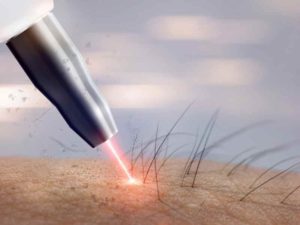Contents
- 1 How many sessions of laser hair removal are needed for permanent hair reduction?
- 1.1 Introduction
- 1.2 The Science behind laser hair removal
- 1.3 How many sessions are required for permanent hair reduction?
- 1.4 How often should laser hair removal sessions be scheduled?
- 1.5 Factors that can affect the efficacy of laser hair removal near me
- 1.6 The benefits and risks of laser hair removal
- 1.7 Booking a Consultation
How many sessions of laser hair removal are needed for permanent hair reduction?
Introduction
Explanation of laser hair removal
Laser hair removal is a cosmetic procedure that has gained immense popularity in recent years due to its effectiveness in providing long-lasting hair reduction. The procedure works by using a concentrated beam of light to target the melanin pigment in hair follicles. The light energy is absorbed by the pigment, which then heats up and destroys the follicle, preventing future hair growth.
The importance of permanent hair reduction
The importance of permanent hair reduction cannot be overstated, particularly for individuals who struggle with excessive or unwanted hair growth. Laser hair removal provides a permanent solution that eliminates the need for frequent and time-consuming hair removal methods like shaving, waxing, or plucking. It is also a convenient option for individuals who may have sensitive skin or are prone to skin irritation from other hair removal methods.
Purpose of the article
The purpose of this article is to provide a comprehensive overview of the number of sessions required for permanent hair reduction through laser hair removal. We will explore the science behind the procedure, the factors that influence the number of sessions required, and the benefits and risks associated with the treatment. Additionally, we will provide guidance on how to schedule laser hair removal sessions for optimal results, as well as future developments in laser hair removal technology.
The Science behind laser hair removal
The mechanism of laser hair removal
Laser hair removal is a non-invasive cosmetic procedure that works by using a highly concentrated beam of light that is absorbed by the melanin pigment in the hair follicles. The light energy is converted into heat, which damages the hair follicle and inhibits future hair growth. The procedure is highly effective at selectively targeting hair follicles while leaving surrounding skin tissue unharmed.
Types of lasers used for hair removal
There are several types of lasers used for hair removal, each with its own set of advantages and disadvantages. Some of the most common types of lasers used for hair removal include alexandrite, diode, Nd:YAG, and IPL (intense pulsed light) lasers. The choice of laser will depend on several factors, including the individual’s skin type, hair color, and the location of the treatment area.
Factors that can influence the effectiveness of laser hair removal
Several factors can influence the effectiveness of laser hair removal, including hair color, skin type, hair thickness, and the location of the treatment area. Darker hair tends to absorb laser light more effectively, making it easier to target the hair follicle. Conversely, lighter hair colors, such as gray or white, may not be suitable for laser hair removal because the hair does not contain enough melanin pigment to absorb the laser light effectively. Skin type is another important consideration, as individuals with darker skin tones may be at a higher risk of developing hyperpigmentation or scarring.
Skin and hair types that are suitable for laser hair removal
Laser hair removal is generally safe for all skin types, but it is important to consider the individual’s skin and hair type when selecting a laser for treatment. Alexandrite and diode lasers are generally most effective for individuals with fair to medium skin tones and dark hair, while Nd:YAG lasers are more suitable for individuals with darker skin tones. IPL lasers may be suitable for a wider range of skin and hair types, but they are generally less effective than other types of lasers. It is important to consult with a trained professional to determine the most suitable laser for the individual’s needs.
How many sessions are required for permanent hair reduction?
The standard number of sessions
Laser hair removal is a process that requires a series of sessions to achieve permanent hair reduction. The standard number of sessions recommended by most practitioners is usually between six to eight treatments spaced four to six weeks apart. This allows the laser to target hair follicles in different stages of growth and ensures that all hair follicles are treated.
Factors that influence the number of sessions required
Several factors can influence the number of sessions required for permanent hair reduction through laser hair removal. One of the most important factors is the individual’s hair color and thickness. Individuals with darker, coarser hair tend to require fewer sessions than those with lighter, finer hair. The location of the treatment area can also impact the number of sessions required, as some areas of the body, such as the face or bikini area, may require more sessions than others.
The importance of scheduling sessions appropriately
Scheduling sessions appropriately is crucial for achieving optimal results. Most practitioners recommend waiting four to six weeks between sessions to allow the hair follicles to cycle through the growth phase. Scheduling sessions too close together can result in suboptimal results, while waiting too long between sessions can prolong the treatment process.
Maintenance sessions
While laser hair removal provides permanent hair reduction, some individuals may require maintenance sessions to maintain their results over time. The frequency of maintenance sessions can vary, but they are typically required every six to twelve months. It is important to discuss maintenance sessions with a trained professional to determine the most appropriate schedule based on the individual’s needs.
Factors that can impact the success of laser hair removal
There are several factors that can impact the success of laser hair removal and the number of sessions required for permanent hair reduction. Some of these factors include the individual’s age, hormonal changes, and certain medical conditions or medications. For example, individuals with polycystic ovary syndrome (PCOS) may require more sessions due to the excess hair growth associated with this condition. It is important to discuss any underlying medical conditions or medications with a trained professional before undergoing laser hair removal to ensure that it is safe and effective for the individual.
Individual variability
It is important to note that every individual’s response to laser hair removal is unique, and the number of sessions required for permanent hair reduction may vary. Some individuals may require more or fewer sessions than the standard number, depending on several factors, including the individual’s hair and skin type, the location of the treatment area, and the intensity of the laser used. A trained professional can assess the individual’s needs and provide a personalized treatment plan to achieve optimal results.
How often should laser hair removal sessions be scheduled?
Recommended Treatment Schedule
The recommended treatment schedule for laser hair removal varies depending on the individual and the area being treated. However, in general, most people will require six to eight treatment sessions spaced four to eight weeks apart to achieve permanent hair reduction.
Treatment Frequency
The frequency of laser hair removal treatments is typically determined by the hair growth cycle. Laser hair removal is most effective during the anagen phase of hair growth when the hair follicle is actively producing hair. Therefore, treatments are spaced apart to allow the hair follicles to transition through the hair growth cycle and for new hair to enter the anagen phase. Most individuals will require four to eight weeks between treatments to achieve optimal results.
Treatment Time Frame
The timeframe for laser hair removal treatment can vary depending on the area being treated, the thickness of the hair, and the individual’s response to treatment. Smaller areas, such as the upper lip or underarms, may only take a few minutes to treat, while larger areas, such as the back or legs, may take up to an hour. The duration of each treatment session can also vary depending on the individual’s pain tolerance and the type of laser used.
Factors Affecting Treatment Schedule
Several factors can affect the laser hair removal treatment schedule, including the individual’s skin and hair type, hair thickness, and the area being treated. Individuals with fair skin and dark hair tend to respond better to laser hair removal and may require fewer treatment sessions. Thicker hair may require additional treatment sessions, while thinner hair may require fewer. The area being treated can also affect the treatment schedule, with smaller areas requiring fewer sessions than larger areas. Additionally, hormonal imbalances or medical conditions that affect hair growth can require additional treatment sessions.
Maintenance Sessions
After completing the recommended number of sessions, some individuals may require maintenance sessions to maintain the results of the treatment. These maintenance sessions are typically spaced several months apart and can help ensure long-lasting hair reduction.
Post-Treatment Care
Following laser hair removal treatment, it is essential to take proper care of the skin to ensure optimal results and reduce the risk of complications. This includes avoiding sun exposure, using sunscreen, and avoiding activities that can irritate the skin, such as hot baths or strenuous exercise. Additionally, individuals should avoid plucking, waxing, or threading the treated area between sessions as this can interfere with the hair growth cycle and reduce the effectiveness of the treatment.
Factors that can affect the efficacy of laser hair removal near me
Hormonal changes
Hormonal changes: Hormonal changes in the body can affect the efficacy of laser hair removal. For example, conditions like polycystic ovarian syndrome (PCOS) or thyroid disorders can cause hormonal imbalances that can result in unwanted hair growth. Hormonal changes during pregnancy and menopause can also affect hair growth patterns, making laser hair removal less effective.
Medications
Medications: Certain medications, such as antibiotics and acne medications, can make the skin more sensitive to light and increase the risk of burns or other complications during laser hair removal treatment. It’s important to inform your laser hair removal technician of any medications you are taking before undergoing treatment.
Sun exposure
Sun exposure: Sun exposure can affect the efficacy of laser hair removal, as the treatment is more effective on lighter skin tones. Sun exposure can cause the skin to darken, making it more difficult for the laser to target the hair follicles. It’s important to avoid sun exposure and tanning for at least two weeks before and after treatment.
Skin conditions
Skin conditions: Skin conditions such as eczema, psoriasis, or rosacea can affect the efficacy of laser hair removal. These conditions can make the skin more sensitive and prone to irritation, which can increase the risk of complications during treatment. It’s important to inform your laser hair removal technician of any skin conditions you have before undergoing treatment.
The benefits and risks of laser hair removal
Benefits of laser hair removal
- Long-term reduction in hair growth: Laser hair removal can provide long-term reduction in hair growth, with some people experiencing permanent hair loss.
- Precision: Laser hair removal can target specific areas of the body and can be used on most parts of the body, including the face, legs, arms, underarms, bikini area, and back.
- Speed: The treatment is relatively quick, with smaller areas such as the upper lip taking only a few minutes to treat, and larger areas such as the back taking up to an hour.
- Convenience: Laser hair removal can save time and money in the long run compared to temporary hair removal methods such as shaving, waxing, and depilatory creams.
Risks of laser hair removal
- Skin damage: Laser hair removal can cause skin damage, such as burns, blisters, or scarring, if the treatment is not performed correctly or the appropriate settings are not used.
- Pain and discomfort: Laser hair removal can cause pain and discomfort during treatment, which can vary depending on the area of the body being treated, the individual’s pain tolerance, and the type of laser being used.
- Changes in skin color: Laser hair removal can cause changes in skin color, such as hyperpigmentation (darkening of the skin) or hypopigmentation (lightening of the skin), especially in people with darker skin tones.
Post-treatment care
- Avoid sun exposure: It is important to avoid sun exposure and tanning for at least two weeks before and after treatment.
- Avoid hot baths and showers: Avoid taking hot baths or showers for 24 to 48 hours after treatment to prevent irritation and burns.
- Use sunscreen: Use a broad-spectrum sunscreen with an SPF of at least 30 on the treated area for at least two weeks after treatment.
- Avoid abrasive or irritating skin products: Avoid using abrasive or irritating skin products such as exfoliants, scrubs, and toners on the treated area for at least two days after treatment.
Booking a Consultation
For more information please visit our capital aesthetics site or call (613) 355-1455



